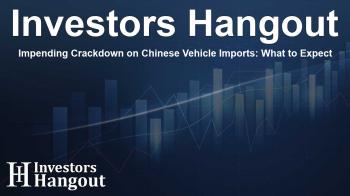Impending Crackdown on Chinese Vehicle Imports: What to Expect

New Regulations on Chinese Vehicle Imports
The U.S. government is gearing up to implement significant regulations that will notably impact Chinese vehicle imports. U.S. Commerce Secretary Gina Raimondo recently confirmed that rules targeting Chinese vehicle software and hardware will be finalized shortly. This announcement piques the interest of many within the automotive sector and raises pertinent questions regarding market dynamics.
Implications of Proposed Regulations
The proposed regulations, initially introduced in September, aim to bar critical Chinese technology from being utilized in connected vehicles within the United States. Specifically, these measures could prevent Chinese-made vehicles from accessing the American market, prompting a ripple effect across the automotive industry. Major automakers, including the likes of General Motors (NYSE: GM) and Toyota Motor (NYSE: TM), are being urged to eliminate essential Chinese components from their vehicles if they wish to sell in the U.S.
Rationale Behind the Regulations
Raimondo expressed that the decision stems from national security concerns. In her words, the government wants to ensure the safety of American roads and prevent the scenario where a significant number of Chinese vehicles could present potential threats. The urgency in finalizing these regulations indicates the administration's commitment to safeguarding national interests.
Industry Response to the Regulatory Changes
The Alliance for Automotive Innovation, which represents a multitude of major car manufacturers, has voiced their concerns regarding the timeline set for compliance. In discussions held in October, these automakers sought an extension of at least one additional year before the hardware requirements are imposed. This request illustrates the challenges that manufacturers may face in adapting to new regulations while ensuring their products remain competitive and compliant.
Call for Extended Deadlines
Prominent industry organizations, including the Consumer Technology Association, have echoed this sentiment, advocating for further extensions. They suggest that both strict deadlines be pushed back by a grace period of two years. This would allow ample opportunity for crucial testing, validations, and the updating of necessary contracts, which are integral to successful compliance with the new regulations.
Tariffs on Chinese Imports
The regulatory framework is not the only area where the Biden administration is taking a strong stance against Chinese imports. Previous decisions have solidified steep tariffs on various Chinese goods, including a staggering 100% tariff on electric vehicles. This aggressive tariff policy reflects a broader strategy to re-evaluate trade relationships and encourage domestic production.
Looking Ahead: Potential Changes
As discussions around these regulations and tariffs continue, automobile manufacturers must reconsider their strategies to navigate this evolving landscape. The industry is faced with the dual challenge of complying with new regulations while simultaneously adapting to changing market conditions.
Future of U.S.-China Automotive Relations
Through all these changes, it is noteworthy to mention the evolving relationship between the U.S. and Chinese automakers. While President-elect Donald Trump has previously indicated a desire to restrict Chinese auto imports, he has also expressed openness to attracting Chinese automakers to establish manufacturing plants in the U.S. This dual approach underlines the complexity of trade dynamics and the potential for future collaborations despite significant regulatory barriers.
Final Thoughts
The impending regulations on Chinese vehicle imports will undoubtedly reshape the automotive landscape. Stakeholders across the supply chain must prepare for these changes, adapting their business practices and strategies accordingly. As we move forward, the focus remains on balancing national security interests while fostering a competitive market environment.
Frequently Asked Questions
What are the main objectives of the new vehicle regulations?
The primary objective is to address national security concerns by prohibiting the use of key Chinese software and hardware in vehicles sold in the U.S.
When do the proposed regulations come into effect?
Software prohibitions are set for the 2027 model year, while hardware bans are scheduled to begin in 2029.
How are automakers reacting to these new regulations?
Many major automakers are requesting extensions on compliance deadlines to ensure adequate preparation and testing can be conducted.
What is the current stance of the Biden administration on tariffs?
The administration has imposed steep tariffs on Chinese imports, including a 100% tariff on electric vehicles, aiming to protect domestic production.
Will these regulations affect the availability of Chinese cars in the U.S.?
Yes, if enforced, the regulations could substantially reduce or eliminate the presence of Chinese-made vehicles in the U.S. market.
About Investors Hangout
Investors Hangout is a leading online stock forum for financial discussion and learning, offering a wide range of free tools and resources. It draws in traders of all levels, who exchange market knowledge, investigate trading tactics, and keep an eye on industry developments in real time. Featuring financial articles, stock message boards, quotes, charts, company profiles, and live news updates. Through cooperative learning and a wealth of informational resources, it helps users from novices creating their first portfolios to experts honing their techniques. Join Investors Hangout today: https://investorshangout.com/
Disclaimer: The content of this article is solely for general informational purposes only; it does not represent legal, financial, or investment advice. Investors Hangout does not offer financial advice; the author is not a licensed financial advisor. Consult a qualified advisor before making any financial or investment decisions based on this article. The author's interpretation of publicly available data shapes the opinions presented here; as a result, they should not be taken as advice to purchase, sell, or hold any securities mentioned or any other investments. The author does not guarantee the accuracy, completeness, or timeliness of any material, providing it "as is." Information and market conditions may change; past performance is not indicative of future outcomes. If any of the material offered here is inaccurate, please contact us for corrections.
